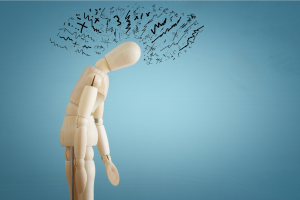Do You Identify as an Anxious Person?
 Have you ever thought to yourself or even voiced out loud that you are “an anxious person?”
Have you ever thought to yourself or even voiced out loud that you are “an anxious person?”
A little known truth about how our brain works is that wherever our attention goes, our energy flows, and that influences the decisions, actions and consequences that follow.
Have you ever had the experience of wanting to buy a new car, and soon after you start noticing that car everywhere? Or started thinking about getting ready to have a baby, and start seeing more pregnant women around?
That’s a part of your brain called the Reticular Activating System (RAS) determining what’s most important to pay attention to.
When you think of yourself as “an anxious person” repeatedly, you wake this part of the brain up and focus its attention on things that will reinforce that limited identity.
If you tell yourself, “I’m just an anxious person,” I know for certain that you will continue to get stuck in the same repeated patterns of anxiety.
Why?
Because we act in concert with who we believe we are.
If you define yourself as someone who is like Eeyore, it’s unlikely you’re going to make lemons out of lemonade or take risks. If you define yourself as a social butterfly, this is how you act; you don’t act like Eeyore, because “this is not who you are.”
There is a deep fundamental need in every one of us to have certainty.
Our brains are wired to survive, not be happy. They’re wired to keep us safe, and in order to ensure we’re safe, they seek certainty. With certainty we get safety, and that bottom-of-the-brainstem survival instinct will trump everything else if left alone.
If you believe “I am an anxious person,” that’s usually said with some level of certainty, right? In that case, your brain is happy: it has completed it’s imperative, but are you happy?
My guess is your answer would be no.
Have you ever been posed with an opportunity, but you instantly responded with or thought, “that’s not me, I’m not that kind of person”?
Consider for a moment:
When did you first define yourself as a stressed-out, anxious or fearful person (or whatever you consider your identity to be)?
When was it that you decided what you were capable and not capable of? Was it 5, 10, 20 years ago?
Whenever it was, those beliefs and standards become the boundaries that define our perceptions that control us.
When calves live on a ranch, at a very young age they are put into a ring with electric fencing. The calves bump up against the fence a few times, and quickly learn that if they try and get out, they’ll get shocked. At that point the ranchers can turn off the electric fence, because the calves are now conditioned and not going anywhere.
The same is true for us, and the beliefs we hold about ourselves.
I used to struggle deeply with insomnia. I would tell myself and even some people around me, “I’m an insomniac” – essentially, I’m an anxious person at bedtime. If you’ve ever had insomnia, you know how awful that can be.
But I started to realize that the more I focused on the worries about going to sleep, the harder it was to go to sleep. What would happen if I could train myself to focus on something else, would I sleep better?
Could I shed the identity of being an “insomniac”?
I began shifting my focus to other things at bedtime, away from those worries, and more toward the experience of rest. The process was so simple (not always easy), but over time, in shifting my focus, I was able to shift my energy, and began noticing falling to sleep sooner with greater regularity.
Often times we stay trapped because underneath it all we’re afraid that if we try, we might fail or get hurt.
I’m going to tell you something you may not believe:
You are NOT a stressed out, anxious or fearful person.
The belief that you are an anxious person is actually reinforcing anxiety and fear in your life. When you look at the fearful thoughts you have, you’ll see that most of them, if not all, are simply not true.
But remember, whatever anyone believes is their identity, is the life they live. Playing small is not your true nature – Why live a limited life?
This conversation alone could bring a level of mindfulness or awareness to pop you out of unhealthy limiting beliefs and have an impact on your freedom and happiness.
But I want to give you another exercise to help it go deeper.
Identify your limiting beliefs – Take a moment to think about what this limiting belief keeps you from? What does it hold you back from engaging or even trying to do? What are you missing out on in life in believing that you are an anxious or fearful person? What would be different if that thought wasn’t there?
Know what you want – Tell your brain WHAT you want. Is it to calm your anxiety? In any particular areas of life? Is it to turn down the self-critic and pay attention to what’s good or the possibilities ahead? Is it to focus on what matters more in the moments of your life? Get clear on it, and let your brain know.
Embody it – Because your limiting beliefs are embodied, we need to communicate with that area of the brain. In other words we need to “feel” the success of what want in our bodies. You can do this through visualizing or writing down any future scenario where you’d be feeling anxious and visualize yourself being confident in that situation. What do you see differently, what do you do differently? This helps let your brain know the outcome your after.
Now remember, the brain is highly influenced by emotions; it pays attention and remembers emotional experiences best. So, make sure to really get into this practice!
Celebrate that moment in your mind: feeling so happy that you have transformed your relationship with anxiety.
The more you get into the visualization, the more you can feel it in your body, the better. We are influencing the implicit areas of the brain, navigating the brain toward the future we want, while pairing it with a positive emotion to tell it that this is important to us to pay attention to.
I hope this makes sense. I know this work is simple, but not easy.
Tags: anxiety, anxious, mental health, mindfulness, self-understanding, stress, stress management3 Comments
Comments are closed.









Well done great topic from great elisha ?thank u very much realy incredible, i try different anxiolytic but this topic best of them
Thanks
Thank you so much!! this is the truth